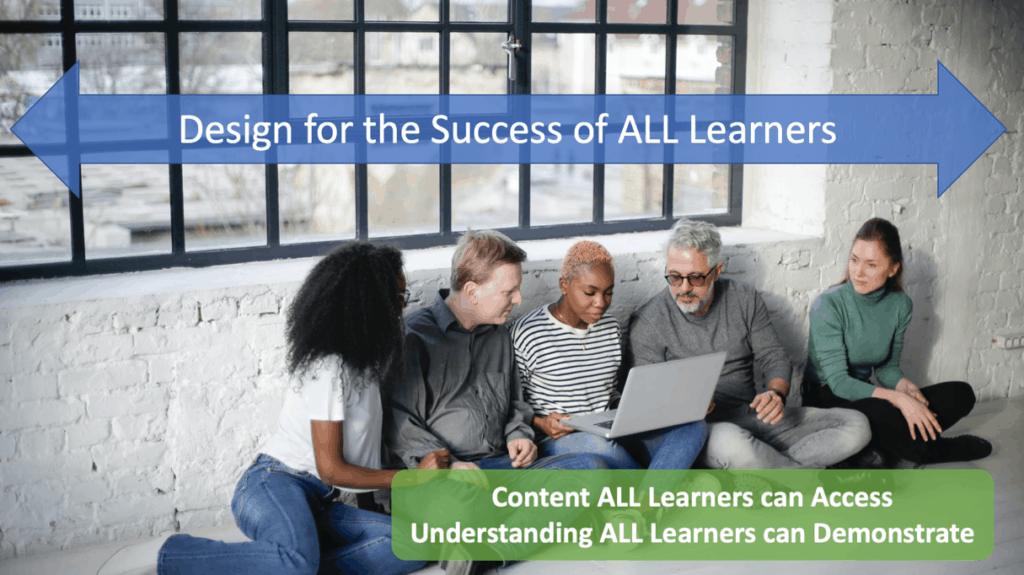
In Todd Rose’s TED Talk, The Myth of Average, he urges ‘designing to the edges,’ a phrase which has been defined as a design method that focuses on a range of abilities in learners rather than on the average learner. Both Designing to the Edges (D2tE) and Universal Design for Learning (UDL) similarly focus on designing instruction that reaches the most students as possible.
UDL encourages designers to “…create accessible and diverse learning environments that support all learners.”1 Project-based learning (PBL) is a design approach that encourages the application of skills to a project where students can contribute to their strengths and exercise growth for their learning gaps, thereby reaching all learners by designing to their unique set of abilities.
Design to the Edges
Designing to the Edges is a design mindset that each learner has varying abilities for each area within a complex set of skills. This approach goes beyond the desire to help struggling learners and meet students where they are at by acknowledging that students who may appear to be struggling in one area have strengths in other areas and those who seem strong also have areas that need to be strengthened.2 People who adopt the D2tE mindset embrace a bold assertion, that by designing to the average learner, you are designing for none of your learners. When you are designing for no one rather than for all, you will lose talent, which is evident in K-12, community college, and university dismal graduation rates. All this in a time when we can’t afford to lose talent. And the talent we are losing is vital, with Todd Rose reporting we lose 50,000 of our brightest minds every year.3
Many people believe that within a classroom there are strong, average, and weaker students. However, we need to see the students within a classroom as each having various abilities dependent upon what we are measuring. Todd Rose supports that students have various strengths, averages, and weaknesses creating an individual ‘jagged profile.’ Designers need to consider that students don’t have a streamlined learning profile and design courses to capture the strengths, push forward the averages, and grow the weaknesses of our students. We must design courses so that we don’t lose talent and in ways that all learners can contribute to the collective synergistic learning that happens when students participate actively in the class. Designing to the edges can look differently based on the age of the learners, content being taught, and the pre-existing knowledge level of the learners.
In an advanced instructional design graduate course I taught, students use leading design software to increase their skills, build their portfolio when they interview, and also strengthen their resumes so they are strong candidates. I noticed when I incorporated the software that only a few students were able to really showcase high-level skills. Upon further investigation, they were the students who had used the software previously.
I changed the assignment so that instead of having the final product be turned in and graded, students needed to draw out what they were wanting to design (no software experience needed). Then students were to create a plan of how they would use the software to design their drawing. Peers who knew the software previously were able to help give advice to the plan prior to it being put into action. Their drawings and the peer-reviewed plans were turned in. Students were then able to practice with the software to create their drawn idea. The outcomes were shocking! More students were able to contribute to the discussions, final products were higher quality, and it was easier to accurately measure growth.
Universal Design for Learning
Designers who have embraced UDL consistently have to clarify that UDL is not for accessibility but rather for access. Designing learning experiences so that you reach all learners provides multiple means of engagement, representation, and action and expression.4 Dr. Katie Novak’s analogy for UDL versus differentiated instruction (DI) is where a person hosting a dinner party can design a different meal for each guest to accommodate their allergies/eating preferences (DI) or the host can offer a buffet where guests can make their own plate (UDL).5 Everyone is enjoying the meal without looking noticeably different from the guest sitting next to them.
Building upon this analogy, often what happens is neither scenario, but a meal that has a set offering where every plate looks the same, with some leaving nourished and others malnourished. UDL encourages using various ways for learners to access course content, such as video, audio, and written components, and to demonstrate new understanding.
Three examples of incorporating UDL in a course that have been successful for me are Dear Abby case studies, scaffolding, and assignment menus. In a doctoral leadership course, students were put into small groups and given a ‘Dear Abby’ case study that was a short, less than a page, complex problem with various possible solutions. The small groups had a set amount of time to discuss possible solutions, incorporating their own past experiences. Students constructed a response that incorporated their experiences, individual talents, and real-world application. The complex nature of the problem allowed various voices to provide input to the multi-layer solution.
Any course with a large paper or project due could incorporate scaffolding where a large assignment is broken up over smaller assignments that all build toward the final deliverable. The smaller assignments give opportunities for the instructor to check-in and provide feedback to the student along the way rather than at the end when the student could be far off course. This worked well for me when teaching a graduate research methods course where students could turn in sections of the assignment. I could not only check if they were applying the correct principles but also that each section fit together. For example, were the research questions written correctly and did they appropriately tie to the problem statement?
Assignment Menus provide a way for learners to use various ways to demonstrate learning and understanding. In a technology course, students were able to choose among assignments with various point values in a menu that equals a specified value. Students could select assignments such as creating a video, writing a paper, designing an infographic, etc. to show learning.
Project-based learning
Project-based learning allows the flexibility for all learners to shine by contributing their strengths and growth by stretching where they have learning gaps.6 Project-based learning not only meets students where they are, but allows students to showcase their skills and add new skills to their toolkit.
In a graduate-level advanced instructional design course I teach at North Carolina State University, teams of students design a project for a real-life client. Students are able to contribute their strengths whether it is videography, design software, scripting, voice, etc. The course is a required course for a master’s program and not all students who register want to be instructional designers when they graduate. Despite varied career goals or past design experience, all students are valuable and can contribute to the team. Students are able to select a task that will utilize their strengths or will stretch them to gain new skills. PBL has been a powerful course design tool for inclusive teaching that reaches all students and gives every student’s unique skill set a chance to shine.

Impact of flexible design
Imagine a classroom where a student consistently is unable to adequately express the synthesis of textbooks, course content, and life experiences in a written paper. The student consistently receives low grades because the snapshot of their understanding is in writing, which is not the student’s strength.
Now imagine allowing the flexibility for the student to produce a mock infomercial and seeing growth in their synthesis. Allowing students to absorb content and display learning in various ways increases the accuracy of assessing learning such as grades. Additionally, instructors will have a more accurate picture of the learning happening in their classrooms. Design to the edges of all students’ individual strengths, averages, and weaknesses so that we can capture and give credit for the talent within our students — giving more measures to assess success.
Whether you adopt UDL principles, create PBL projects, or incorporate other personalized learning techniques, when you design to the edges, you are designing for the growth and success for all learners. Isn’t that what providing education is all about anyway? Don’t let talent fall through the cracks in a time when we have such a great need for profound minds to tackle some of the challenging environmental, political, medical, and educational issues on a global level. Let’s not miss out on the brilliant solutions to these complex issues that will come from minds that wouldn’t be reached by an education designed for the elusive, non-existent average.

